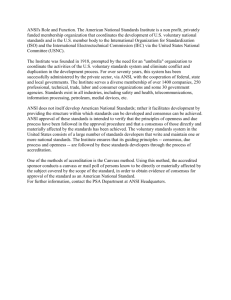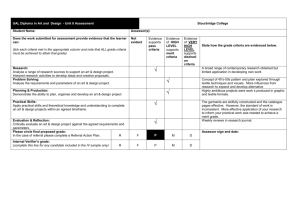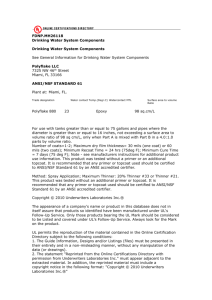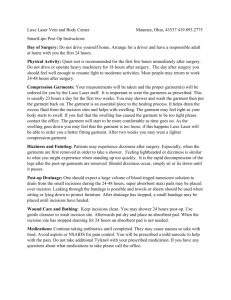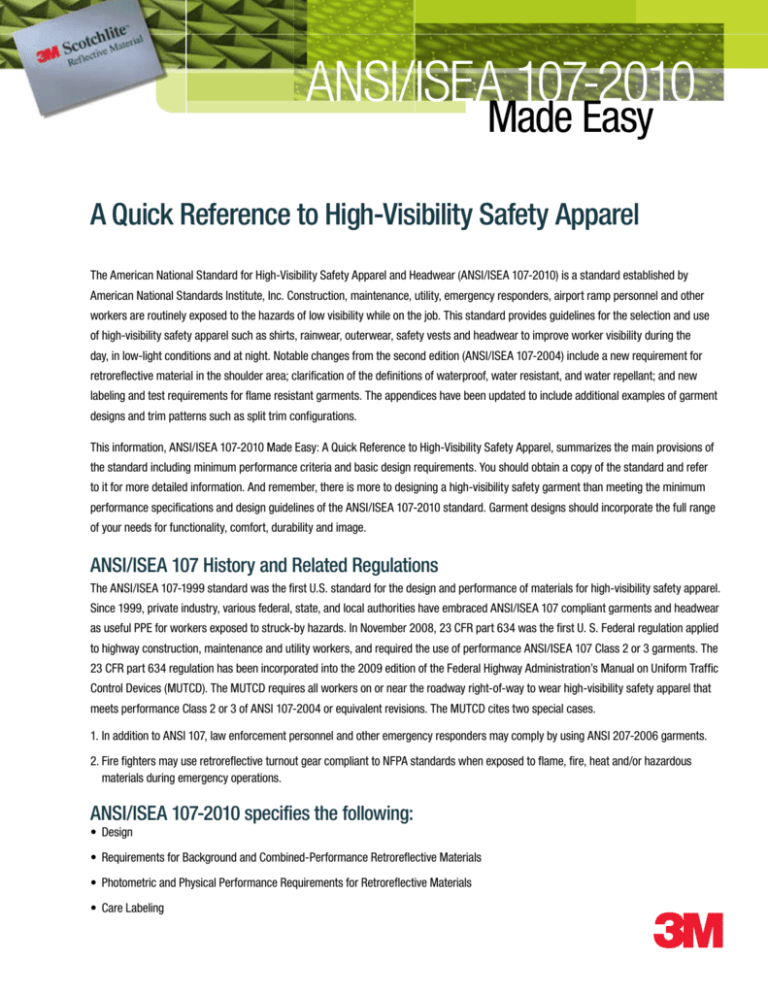
ANSI/ISEA 107-2010
Made Easy
A Quick Reference to High-Visibility Safety Apparel
The American National Standard for High-Visibility Safety Apparel and Headwear (ANSI/ISEA 107-2010) is a standard established by
American National Standards Institute, Inc. Construction, maintenance, utility, emergency responders, airport ramp personnel and other
workers are routinely exposed to the hazards of low visibility while on the job. This standard provides guidelines for the selection and use
of high-visibility safety apparel such as shirts, rainwear, outerwear, safety vests and headwear to improve worker visibility during the
day, in low-light conditions and at night. Notable changes from the second edition (ANSI/ISEA 107-2004) include a new requirement for
retroreflective material in the shoulder area; clarification of the definitions of waterproof, water resistant, and water repellant; and new
labeling and test requirements for flame resistant garments. The appendices have been updated to include additional examples of garment
designs and trim patterns such as split trim configurations.
This information, ANSI/ISEA 107-2010 Made Easy: A Quick Reference to High-Visibility Safety Apparel, summarizes the main provisions of
the standard including minimum performance criteria and basic design requirements. You should obtain a copy of the standard and refer
to it for more detailed information. And remember, there is more to designing a high-visibility safety garment than meeting the minimum
performance specifications and design guidelines of the ANSI/ISEA 107-2010 standard. Garment designs should incorporate the full range
of your needs for functionality, comfort, durability and image.
ANSI/ISEA 107 History and Related Regulations
The ANSI/ISEA 107-1999 standard was the first U.S. standard for the design and performance of materials for high-visibility safety apparel.
Since 1999, private industry, various federal, state, and local authorities have embraced ANSI/ISEA 107 compliant garments and headwear
as useful PPE for workers exposed to struck-by hazards. In November 2008, 23 CFR part 634 was the first U. S. Federal regulation applied
to highway construction, maintenance and utility workers, and required the use of performance ANSI/ISEA 107 Class 2 or 3 garments. The
23 CFR part 634 regulation has been incorporated into the 2009 edition of the Federal Highway Administration’s Manual on Uniform Traffic
Control Devices (MUTCD). The MUTCD requires all workers on or near the roadway right-of-way to wear high-visibility safety apparel that
meets performance Class 2 or 3 of ANSI 107-2004 or equivalent revisions. The MUTCD cites two special cases.
1.In addition to ANSI 107, law enforcement personnel and other emergency responders may comply by using ANSI 207-2006 garments.
2.Fire fighters may use retroreflective turnout gear compliant to NFPA standards when exposed to flame, fire, heat and/or hazardous
materials during emergency operations.
ANSI/ISEA 107-2010 specifies the following:
• Design
• Requirements for Background and Combined-Performance Retroreflective Materials
• Photometric and Physical Performance Requirements for Retroreflective Materials
• Care Labeling
Definitions
Retroreflective, combined-performance, and background materials must be certified to the specific performance requirements in the
standard. High-visibility safety apparel manufacturers must make documentation available to verify that the finished garments also meet
the requirements of the standard.
Background material: Colored fluorescent material intended to be highly conspicuous, but not intended to comply with the requirements
of this standard for retroreflective material.
Retroreflective material: Material that reflects and returns a relatively high proportion of light in a direction close to the direction from
which it came.
Combined-performance material: A retroreflective material that is also a fluorescent material. Combined-performance materials can be
counted toward the minimum area requirements for background material specified in Table 1.
Compliance: Retroreflective, combined-performance and background materials are to be certified to the performance requirements in the
standard. Manufacturers of the finished garment must make documentation available to verify that components used to make high-visibility
garments meet the requirements of the standard.
Certify (background and retroreflective material): To obtain compliance certification documents based on testing from an independent,
third party accredited laboratory to verify performance requirements as specified in the standard.
Certify (finished item): To provide documentation from either an independent third-party accredited laboratory or to self-certify through
the use of the Apparel and Headwear Compliance Certificate. (Appendix D6)
Accredited laboratory: A laboratory having a certificate of accreditation meeting the requirements ISO/IEC 17025:2005 General
requirements for the competence of testing and calibration laboratories (or other equivalent standard) for the collection and analysis of data
within the parameters of this standard.
Design
The ANSI/ISEA 107-2010 standard provides design guidelines and specifies the photometric requirements, minimum amounts of
component materials, colors, and placement to create garments and headwear for the purpose of enhancing the visibility of workers. Refer
to Section 6 of the standard for more detailed information. The selection of components and classes of apparel should be made based upon
what is appropriate for the hazard and with the safety of the worker in mind.
Component Colors
There are three different colors for background and combined-performance material from which to choose: fluorescent yellow-green,
fluorescent orange-red and fluorescent red. Users should consider the work and natural environment to determine the most conspicuous
color for daytime use. Is the environment urban or rural, heavy foliage or desert? Are work zone devices and equipment yellow or orange?
Choose the fluorescent color that achieves the highest degree of worker contrast.
2
Garment Classes
Three classes of high-visibility safety apparel help the user choose the proper garments for a work situation. The classes state the minimal
amount of background and retroreflective material, and placement of retroreflective material needed as well as technical requirements for
garment design. Garments that cover the torso, such as T-shirts and safety vests, are intended to meet Class 1 or Class 2 requirements.
Shorts are included in the description of Class E garments.
Class 1 Garments
Class 2 Garments
Class 3 Garments
Retroreflective Material Placement
Class 1 and 2 garments, such as vests and T-shirts, and Class 3 garment designs, such as vest with Class E pants ensembles, coveralls,
outerwear and rainwear should achieve the following:
• Use of retroreflective band widths appropriate for the garment class. (Refer to Section 6.1.1. of the standard.)
• Provide 360° visibility with horizontal gaps of 50 mm or less.
•Garments without reflective material encircling the sleeves, are now required to have 150 cm² (23.25 in²)
of reflective material in the shoulder area, to provide 180° visibility of the wearer. Shoulder area is defined
as measuring 15 cm (5.9 in) down from the shoulder high point, on the front and back of the garment. The
requirement of 23.25 in² is the total amount of reflective material required in the shoulder area including the
front and back of the garment, e.g., shoulder area retroreflective material amount front + rear ≥ 23.25 in².
15 cm
(5.9 in)
• Appropriate separation distances of vertical and horizontal bands placed on the torso, sleeves and trouser areas.
• Appropriate retroreflective band placement and garment design.
•In addition to trim, retroreflective patterns, such as logos, design icons, or identification text may contribute to the maximum area
requirements specified in Table 1.
Requirements for Background and Combined-Performance Materials
Section 7 of the standard provides specifications for color, brightness, fabric strength and moisture resistance after various exposure tests.
•Background and Combined-Performance material needs to be tested for chromaticity or color, and luminance or brightness, when new
and for colorfastness after laundering and Xenon (UV light) exposure. Table 2 in Section 6 is now the requirement for both background
and combined-performance materials.
• Background materials must also be tested for colorfastness after crocking and perspiration tests.
•Other tests for background materials include testing for dimensional change (shrinking) after washing and dry-cleaning, tensile strength,
tear resistance, bursting strength of woven material and bursting strength of knitted material.
•If the garment is intended to provide protection during rainfall, background materials also need to be tested as water repellent, water
resistant, and /or water proof. See Section 7.5 of the standard for updated definitions.
3
Table 1: Minimum areas of visible material – ANSI/ISEA 107-2010
Performance
Class 3
Performance
Class 2
Performance
Class 1
Class E
Headwear
Background material
1240 in² (0.80 m²)
775 in² (0.50 m²)
217 in² (0.14 m²)
465 in² (0.30 m²)
78 in² (0.05 m²)
Retroreflective or
combined-performance
material used in
conjunction with
background material
310 in² (0.20 m²)
201 in² (0.13 m²)
155 in² (0.10 m²)
108 in² (0.07 m²)
10 in² (0.0065 m²)
Level 2
Combined-performance
material used without
background material
NA
NA
310 in² (0.20 m²)
NA
78 in² (0.05 m²)
Level 2 or 1
2 in (50 mm)
1.375 in (35 mm)
1 in (25 mm)
or
2 in (50 mm)
combined-performance
material (without
background material)
2 in (50 mm)
Minimum number of
yards per retroreflective
material width
4.3 yds of 2 in
(50 mm) width
4 yds of 1.375 in
(35 mm) width
2.8 yds of 2 in
(50 mm) width
4.3 yds of 1 in
(25 mm) width
3.1 yds of 1.372 in
(35 mm) width
2.15 yds of 2 in
(50 mm) width
1.5 yds of 2 in
(50 mm) wide
Photometric performance
Level 2 (Table 4) or
Level 1 (Table 5)
Level 2 (Table 4) or
Level 1 (Table 5)
Level 2 (Table 4) or
Level 1 (Table 5)
Level 2 (Table 4) or
Level 1 (Table 5)
Minimum width of
retroreflective material
See Above
Note: Consult the ANSI/ISEA 107-2010 standard for Tables 4 and 5.
Top arm band
placed between
elbow and shoulder
Shoulder area trim provides
human form definition, and
180° visibility of the wearer
Horizontal retroreflective trim
placed at > 2" from bottom
garment hem, provides 360°
of visibility to the wearer
Separation
between bands
must be at
least 2"
Trim ≥ 2" from sleeve
cuff and garment hem
Trim ≥ 2" from pant
bottom hem and at
least a 2" separation
between bands
4
Photometric and Physical Performance Requirements for
Retroreflective and Combined-Performance Materials
Section 8 of the standard specifies photometric and performance requirements for retroreflective and combined-performance materials,
such as minimum brightness after test exposure.
•3M retroreflective and combined-performance materials are certified to ANSI/ISEA 107-2010 specifications. (Refer to the tables in
Section 7 and 8 of the standard.)
•All material must meet the minimum brightness requirements after tests for abrasion resistance, flexing, folding at cold temperatures,
variation in temperatures, influence of rainfall, and laundering. When washing is indicated on the care label, the number of cycles should
be tested per ISO 6330 Method 2A, 60 °C, or dry-cleaning per ISO 3759. (Refer to Section 9 of the standard.)
•Combined-performance material must also meet the minimum luminance or brightness factors after a Xenon exposure test (UV light).
(Refer to Section 7 of the standard.)
XYZ Manufacturer
ANSI/ISEA 107-2010
and ANSI/ISEA 107-2004
100% Polyester
3M™ Scotchlite™ Reflective Material
Model #: Hi Vis Vest
Size: Large
Class 2
Level 2
Care Labeling, General Marking and Instructions for Use
Once all materials have been tested against performance requirements and certificates
of compliance from a third party testing laboratory have been issued, apparel manufacturers
then assemble garments according to the design guidelines in Section 6 of the standard
for the appropriate class of garment. Only after all the materials’ performance and
design requirements have been met, can a garment be labeled ANSI/ISEA 107-2010
compliant. Garment labeling, general marking and instructions for use are described in
Sections 10 to 12 of the standard.
FR- ASTM F1506-08
Washing Instructions
Wash warm Max 25 cycles
Do not bleach
Tumble dry low
Do not iron
Do not dry-clean
Specific Marking
• Marking includes the following information:
•Name, trademark, or other means of identifying the manufacturer or authorized representative.
•Designation of the product type, commercial name or code.
•Size designation.
•Number of this specific ANSI/ISEA standard (ANSI/ISEA 107-2010).
• Compliance with flame resistance can be indicated in one of 2 ways:
1. The letters “FR” on the label followed by the designation of the ASTM standard specification from the list of allowed standards
in Section 9.5.
2. Garments which fully meet the third party certification requirements to NFPA 1971, 1977, or 2112, may use the separate label
indicated by the NFPA standard to indicate FR compliance.
• Pictogram showing the garment Class and Level of performance for the retroreflective material.
• Care labeling with ASTM D5489-07 symbols and maximum cycles for the cleaning process.
• Instructions for Use (if applicable).
5
Answers To Most Frequently Asked Questions:
1.Are there other differences between the ANSI/ISEA 107-2004 and ANSI/ISEA 107-2010 standards? Yes. There are additional
differences between the 2004 and 2010 editions of this standard. See the companion document, “Comparison of ANSI/ISEA 107-2004
Versus ANSI/ISEA 107-2010” for additional information.
2.Does OSHA require the use of high-visibility safety apparel for construction workers working in highway/construction work
zones at risk of being struck by traffic? Yes. Per the OSHA Standard Interpretation, #20080829-8611, dated 8/5/2009, under OSHA
Act OSH Act, 29 U.S.C. §654(a)(1), also known as the General Duty Clause, OSHA requires high-visibility apparel for flaggers, workers
exposed to vehicle traffic near excavations, and for other workers in highway/construction zones which are exposed to traffic. The letter
cited the regulation 23 CFR Part 634, Worker Visibility, which requires garments compliant to ANSI 107 Class 2 or 3.
3.Does this edition of the standard replace the 2004 edition? ANSI 107-2010 replaces the ANSI 107-2004 version. Garment designs
should be written to comply with the new version of the standard.
4.What version of ANSI 107 does MUTCD 2009 require? For all workers, including emergency responders, within the right-of-way
who are exposed either to traffic or to work vehicles and construction equipment within a Temporary Traffic Control zone, MUTCD 2009
Section 6D.03 requires Class 2 or Class 3 garments of ANSI 107-2004 or equivalent revisions, such as ANSI 107-2010. Section 6E.02
requires ANSI 107-2004 Class 2 or 3 for flaggers- FL orange-red or yellow green are required background colors. Section 7D.04 requires
ANSI 107-2004 Class 2 for Adult Crossing Guards¹.
5.What are the new label requirements for ANSI 107-2010, in light of MUTCD 2009? The MUTCD 2009 specifies that the 2004
version or equivalent revisions, e.g., the 2010 version, may be used for compliance to MUTCD, but must be labeled as ANSI 107-2004.
Until an official statement is issued from MUTCD, garments meeting both requirements should be labeled as both ANSI 107-2010 and
ANSI 107-2004¹.
6.Can NFPA 701 be used to claim flame resistance for an ANSI 107-2010 garment? No.
7.Are sleeveless vests with the two horizontal stripes compliant to ANSI 107-2010? No. The 2010 standard requires 23.5 in of
material in the shoulder area for all sleeveless garments. However, garments with sleeves which incorporate bands on the sleeves are
not required to have material in the shoulder area.
2
8.Does the standard only permit the designs that are provided in the Appendix of the standard? No. The designs provided in the
appendix of the standard are only examples. There may be many innovative designs including use of primary apparel such as shirts that
meet the standard and are different from the limited examples in the Appendix. Section 6 of the standard states the design requirements
of the standard.
9.Does open weave or mesh meet the background materials requirements of the standard? ANSI/ISEA 107-2010 is a performance
standard and the material specifications are not written to include or exclude any materials if they meet the requirements for visibility or
durability. Many compliant mesh products are available in the marketplace.
10.I have only found larger-sized garments that meet the standard. I have smaller workers that need appropriately fitting
garments to work safe. Is this being addressed? The following quote was taken from the standard, Section 6.3 Ergonomics
(Page 6). “The garment shall offer the wearer the best possible degree of comfort that is consonant with provision of adequate
protection. The garment shall be designed for correct fit and positioning on the user and should be designed to ensure that it remains in
place for the expected period of use, anticipating environmental factor as well as movements the wearer could adopt during the course
of work.” Health & Safety Managers may wish to consider the selection of a different garment style, such as a vest or shirt with sleeves,
to accommodate small-framed personnel. Access our website at Scotchlite.com to learn more about the ANSI/ISEA 107-2010 standard.
¹Manual on Uniform Traffic Control Devices 2009 Edition pages 564-566, 745
6
11.Is this standard the same as the European EN 471 standard? No. The developers of the standard used many of the requirements of
EN 471 because the science supported the performance criteria that are established. See the 3M website Scotchlite.com for an
explanation of the differences.
12.Does the ANSI 107-2010 standard allow for split trim designs on a Class 2 or Class 3 garment? The split trim configuration, i.e.
two 1" bands of reflective material separated by 2" of background material, is allowed by Section 6.1.1.1 of the standard. See Appendix
C, Figure C-4 for an example.
Six Steps For Selecting High-Visibility Safety Apparel
Step 1: Obtain and review copies of ANSI/ISEA 107-2010 standard and relevant regulations.
Step 2: Conduct a survey of worksite low visibility hazards to determine the appropriate class of garments, as directed by the
2009 MUTCD Section 6D.03 paragraph 03 subparagraph E. Remember that the survey should account for more than speed. Also consider
worker proximity to traffic, other prevailing colors, weather conditions, task loads and the traffic control plan.
Step 3: Working with the 3M team and your safety and design specialists, design concept garments that meet your needs. Remember to
take a comprehensive approach to garment design in order to balance your requirements for garment functionality, comfort and durability.
An ISEA study of construction work zones found that non-use of garments is related to lack of comfort and style. These issues can be
addressed effectively through appropriate designs.
Step 4: Review your design choice with a visibility demonstration and/or wear test.
Step 5: Write a specification based on specific performance criteria. Require use of certified components only.
Step 6: When the safety apparel is issued to your workers, provide them with training that explains the purpose and use of their new
high-visibility garments.
Look to 3M
When it comes to safety apparel, 3M is an industry leader in providing information, research, reflective applications advice, and garment
design consultation. You and your workers can look to 3M for quality, reliability, and product support. Our sales and technical support
staffs want to help you with selection of components and garment design, planning and executing a visibility demonstration, and
developing a garment specification. For more information on how 3M can help you with your high-visibility safety apparel needs,
call 800-328-7098, Ext. 2.
7
Important Notice to User
LIMITED WARRANTY: In the event any 3M™ Scotchlite™ Reflective Material is found to be defective in material, workmanship, or not in
conformation with any express warranty, 3M’s only obligation and your exclusive remedy shall be to replace or refund the purchase price,
at 3M’s option, of such product upon timely notification thereof and substantiation that the product has been stored, maintained and used
in accordance with 3M’s written instructions. EXCLUSIONS TO WARRANTY: THIS WARRANTY IS EXCLUSIVE AND IN LIEU OF ANY IMPLIED
WARRANTY OF MERCHANTABILITY, FITNESS FOR A PARTICULAR PURPOSE OR OTHER WARRANTY OF QUALITY, EXCEPT OF TITLE AND
AGAINST PATENT INFRINGEMENT.
LIMITATION OF LIABILITY: Except as provided above, 3M shall not be liable in contract or tort for any loss or damage, whether direct,
indirect, incidental, special or consequential, (including, without limitation, lost profits, goodwill and business opportunity) arising out of the
sale, use or misuse of the product, or the user’s inability to use the product. THE REMEDIES SET FORTH HEREIN ARE EXCLUSIVE.
PRODUCT USE: Because of the unlimited variety of potential applications for these products, BEFORE production use, the user (which may
be a product designer, product specifier, converter or end product manufacturer or others) must determine that the Products are suitable
for the intended use and are compatible with other component materials. User is solely responsible for determining the proper amount and
placement of Products. While reflective products enhance visibility, no reflective product can ensure visibility or safety under all possible
conditions. 3M may change the product, specifications and availability of the product as improvements are made; therefore, user should
contact 3M for latest information before specifying the product.
3
Occupational Health and
Environmental Safety Division
3M Protective Apparel and
Footwear Market Center
3M Center, Building 0235-02-F-06
St. Paul, MN 55144-1000
800-328-7098
Scotchlite.com
3M Canada
P.O. Box 5757
London, Ontario N6A 4T1
800-267-4414 Technical Service
800-364-35773M HELPS
3M.com/ca/besaferbeseen
3M and Scotchlite are trademarks of 3M.
Please recycle. Printed in U.S.A.
© 3M 2010. All rights reserved.
75-0500-5599-7

